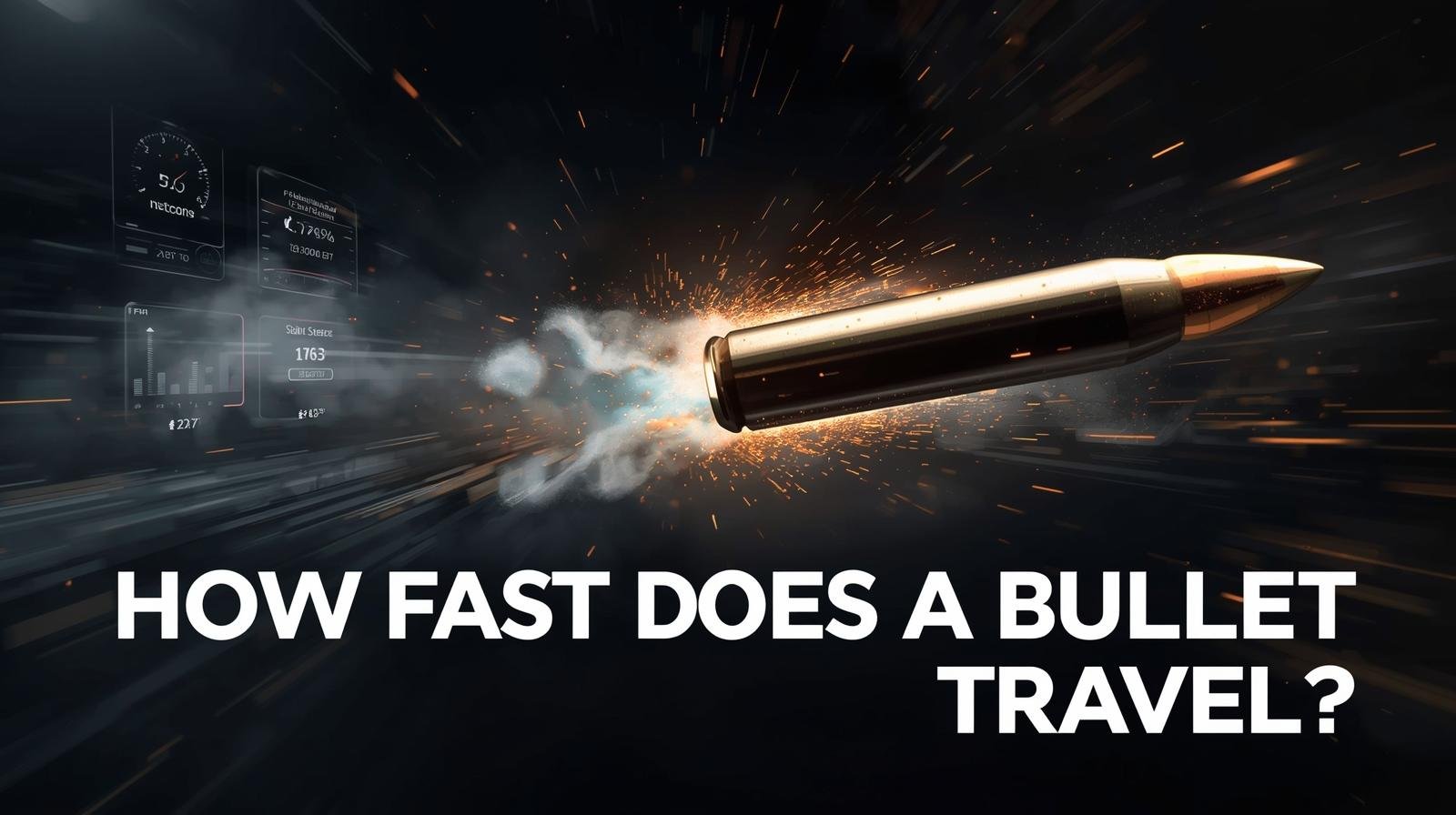People have always been interested in How Fast Does a Bullet Travel , from history buffs to ballistics experts. A small metal projectile can speed up to thousands of feet per second when the trigger is pulled. It can cover distances faster than the eye can see. But how fast does a bullet go? The answer depends on a number of things, such as the type of gun, the type of ammo, and the design of the barrel.
This article goes into great detail about How Fast Does a Bullet Travel, the science behind it, and how different guns stack up against each other.
What Makes Bullets Go Fast?
There are a number of things that affect bullet speed, also known as muzzle velocity:
Type of Firearm: Rifles usually shoot bullets faster than handguns or shotguns because their barrels are longer and their cartridges are stronger.
Caliber and Weight: Lighter, smaller bullets usually go faster, while heavier bullets give up speed for impact force.
Powder Charge: The amount of gunpowder in the cartridge has a direct effect on how fast it goes. More powder means more pressure, which means faster speeds.
Barrel Length: A longer barrel gives the gases that push the bullet more time to expand, which makes it go faster.
Aerodynamic bullets keep their speed better than flat or blunt ones when they are in flight.
Average Bullet Speeds by Type of Gun
Different guns are made for different things, which is why bullet speeds are so different.
1. Handguns
- Handguns are made to be used at short ranges, so their bullets move more slowly than rifle bullets.
- Speed: 700 to 1,500 feet per second (fps)
- A normal 9mm bullet goes about 1,200 fps (365 m/s) on average.
2. Guns
- Rifles are made to be accurate and have a long range, and they shoot bullets very quickly.
- Normal Speed: 2,000–4,000 fps
- For instance, a .223 Remington round, which is common in AR-15 rifles, travels at about 3,200 fps (975 m/s).
3. Shotguns
- Shotguns shoot multiple pellets or slugs at lower speeds most of the time.
- Average Speed: 1,200 to 1,600 fps
- A 12-gauge slug, for example, goes about 1,500 fps on average.
4. Sniper and long-range rifles
- Military sniper rifles are made to shoot very far and very accurately.
- Speed: 2,800 to 3,200 fps
- The .50 BMG cartridge can go almost 3,000 fps, for example.
Bullets that are supersonic and subsonic
At sea level, sound travels at about 1,125 fps (343 m/s). A lot of bullets go faster than this, which makes them supersonic.
- Supersonic bullets go faster than sound and make a loud “crack” when they break the sound barrier. This is the case for most rifle bullets.
- Subsonic bullets go slower than the speed of sound. People often use them with suppressors to make less noise, especially in tactical or covert situations.
For example, regular 9mm bullets are usually supersonic, but there are special subsonic bullets that are quieter.
Examples of Bullet Speed in Real Life
Here are some common guns and the speeds at which their bullets travel:
- 9mm Pistol (Glock 17): About 1,200 fps
- .45 ACP Handgun: about 850 fps
- .223/5.56 Rifle (AR-15): about 3,200 fps
- The.308 Winchester Rifle fires at about 2,800 fps.
- .50 BMG Sniper Rifle: 2,800 to 3,000 fps
- 12-Gauge Shotgun Slug: About 1,500 fps
This comparison shows that the speed of a bullet changes depending on the type and design of the weapon.
The Importance of Bullet Speed in Ballistics
The speed of a bullet is very important to how well it works after it is fired.
Accuracy: Bullets that travel faster are less affected by wind and gravity, which makes them more accurate.
Range: High-speed rounds keep their speed over longer distances.
Speed affects how well a bullet can get through armor, barriers, or tissue.
Energy is proportional to both mass and the square of velocity. This means that faster bullets have a much bigger impact force.
For instance, a .45 ACP handgun bullet may be slower, but it can stop something quickly. A high-speed rifle bullet, on the other hand, can go much farther and hit its target with deadly accuracy.
A Look at Bullet Speed Throughout History
Weapons from the past were much slower than weapons today. Muskets from the 1600s shot lead balls at speeds of about 400 fps, which is only a little faster than modern paintball guns. Over the years, improvements in gunpowder, metallurgy, and ballistics technology have made bullets travel at speeds of 4,000 fps or more. This has changed both hunting and war.
Questions That Are Commonly Asked
1. What is the bullet that goes the fastest?
The .220 Swift rifle cartridge is the fastest commercial round, going up to 4,000 fps (1,220 m/s).
2. Do bullets go faster than sound?
Yes. Most rifle rounds are supersonic, which means they break the sound barrier soon after they leave the muzzle.
3. How far can a bullet go?
Bullets can go anywhere from 1 to 3 miles (1.6 to 4.8 km) depending on the caliber and angle. But accuracy goes down at long ranges.
4. Does going faster always mean you can stop better?
Not all the time. Speed, mass, and bullet design all work together to make stopping power. Bullets that are heavier may not travel as fast, but they can still do a lot of damage.
5. How quickly does a bullet slow down?
That depends on its shape, mass, and speed. Aerodynamic, heavier bullets retain velocity longer; air drag reduces speed continuously, often noticeably within tens or hundreds of meters.
6. Is muzzle velocity the same as impact speed?
Not necessarily. Muzzle velocity is the speed as it exits the barrel; impact speed is whatever it’s reduced to when it hits the target, which can be substantially lower over distance.
How quickly does a bullet travel?
Depending on the gun and ammo, bullets leave the muzzle at velocities of a few hundred to a thousand meters per second. Most handguns, including 9mm pistols, propel rounds downrange at speeds of between 250 to 450 m/s (about 820 to 1,480 ft/s). Most modern centerfire rifles shoot at speeds between 600 and 1,000 m/s (between 2,000 and 3,280 ft/s). Small, fast cartridges like the 5.56×45mm NATO (.223) generally have a muzzle velocity of 800–950 m/s. Low-velocity pistol rounds and shotgun pellets are slower, although very large or specialty rounds may not fit into these ranges.
The type of cartridge, the amount of powder, the form and mass of the bullet, the length of the barrel, and the weather (temperature, altitude, and air density) are all important elements that affect muzzle velocity. The bullet slows down as it travels because of air resistance. Supersonic bullets also make a sonic boom (the “crack”) until they slow down below the speed of sound.
Last Thoughts
So, how quickly does a bullet go? There is no one answer that works for everyone. Most handguns shoot bullets at speeds of 700 to 1,500 feet per second (fps), most rifles shoot bullets at speeds of 2,000 to 4,000 fps, and some special cartridges can shoot bullets at speeds of more than 4,000 fps. Things like the design of the gun, the caliber, and the type of ammo all matter.
Knowing how fast a bullet travels shows how advanced modern ballistics are and how amazing the engineering that goes into making guns is. Bullet speed is one of the most interesting things about weapon technology, whether you look at it from a scientific, historical, or safety point of view.





